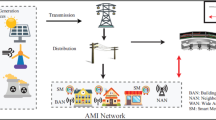Abstract
For energy deficit countries, the design of Supervisory Control and Data Acquisition (SCADA) based energy management systems for optimal distribution is of high interest. Such design involves development of Remote Terminal Unit (RTU) which is considered as an essential component of any high scale SCADA system and it is functioning as remote field data interface. Considering various generations of SCADA, two different designs of an RTU are proposed for third generation (Networked Approach) SCADA in view of energy management applications. One design includes Programmable Logic Controller (PLC) as CPU of RTU and other would involve Field Programmable Gate Array (FPGA) instead of PLC. This paper results in comparative study of two different selections of CPUs for designing an RTU based on performance measurement. PLC based RTU exhibits limited features where as FPGA based RTU possesses unique features like encryption support, radio support and large memory area. Suitable simulation tools are needed in order to determine the best approach. The main objective of this study is to propose a design outline considering significant parameters that facilitates optimized development and low cost implementation of an RTU, also featured with wireless communication. In addition to the optimized design of an RTU by means of comparative study, a brief discussion on optimization of wireless link for Remote Terminal Unit is also presented. This phase involves detailed comparison among various options considering the RF spectrum for optimal solution. This segment of research results in design of optimized wireless link for the planned low cost Remote Terminal Unit (RTU). A scenario depicting multiple RTUs communicating with one Tele-Control Interface (TCI) is discussed to address optimized implementation of wireless SCADA.










Similar content being viewed by others
References
Aamir, M., Poncela, J., Chowdhry, B. S., & Uqaili, M. A. (2012). Impact analysis of renewable energy in national grids for energy deficit countries, Communications in Computer and Information Science, 1, vol. 281, Emerging trends and applications in information communication Technologies, pp. 1–9.
Aamir, M., & Mahmood, A. (2008). Performance analysis of wide area operation, control and protection high scale SCADA system, Electric Power Conference, 2008. EPEC 2008. IEEE Canada.
Bolton, W. (2009). Programmable logic controllers (5th ed.). Amsterdam: Elsevier Newnes.
Regh, J. A., & Sartori, G. J. (2009). Programmable logic controllers (2nd ed.). Englewood Cliffs: Prentice Hall.
Hauck, S., & DeHon, A. (2008). Reconfigurable computing: The theory and practice of FPGA-based computation. Amsterdam: Elsevier Newnes.
Spartan-3 Generation FPGA User Guide. (2011). Available at: www.xilinx.com, UG331 (v1.8) (June 13, 2011).
Collins, D., & Lane, E. (2000). Programmable controllers: A practical guide (1st ed.). New York: McGraw-Hill Book Company.
White paper on SCADA produced by Motorola (2007).
Turner, W. C., & Doty, S. (2007). Energy management handbook. Lilburn: The Fairmont Press, Inc.
Manzini, R., Regattieri, A., Pham, H., & Ferrari, E. (2010). Maintenance information system and failure rate prediction, Springer series in reliability engineering 2010, Maintenance for industrial systems, pp. 189–217.
Yupeng, Y. (2011). Design of digital PLC experimental teaching system. Lecture Notes in Electrical Engineering, 1, vol. 112, Engineering Education and Management, pp. 361–366.
Lazzaroni, M., Cristaldi, L., Peretto, L., Rinaldi, P., & Catelani, M. (2011). Reliability prediction handbooks: Evaluation of the system failure rate. Reliability Engineering, pp. 77–83.
Rabus, B., Eineder, M., Roth, A., & Bamler, R. (2003). The shuttle radar topography mission—A new class of digital elevation models acquired by spaceborne radar. ISPRS Journal of Photogrammetry and Remote Sensing, 57, 241–262.
Mauricio, G., Resende, C., & Pardalos, P. M. (2006). Handbook of optimization in telecommunication. Berlin: Springer.
IEEE Recommended Practice for Data Communications Between Remote Terminal Units and Intelligent Electronic Devices in a Substation. IEEE Std 1379–2000 (Revision of IEEE Std 1379- 1997), (2000, 21 September).
Author information
Authors and Affiliations
Corresponding author
Rights and permissions
About this article
Cite this article
Aamir, M., Poncela, J., Uqaili, M.A. et al. Optimal Design of Remote Terminal Unit (RTU) for Wireless SCADA System for Energy Management. Wireless Pers Commun 69, 999–1012 (2013). https://doi.org/10.1007/s11277-013-1060-9
Published:
Issue Date:
DOI: https://doi.org/10.1007/s11277-013-1060-9




